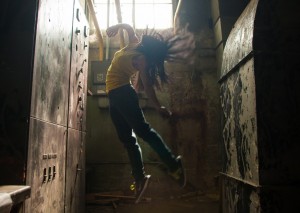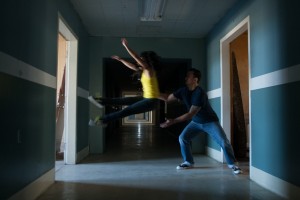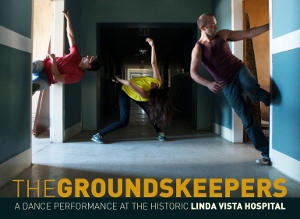A DANCE PIECE THAT’S A KEEPER
The frequency of site-specific events continues to grow exponentially in the City of Angels, but Heidi Duckler has been doing it for many years, creating unique dance performances in spaces as disparate as Laundromats, museums, churches, civic buildings and even a vintage 1961 Oasis trailer. Now she takes us into the shuttered and thought-to-be-haunted Linda Vista Hospital, an historic East L.A. venue slated to be converted into low-income housing. Writer George Moreno’s invented petite remembrances (done in first-person monologues) of those who were patients or worked there are the basis for The Groundskeepers, a series of vignettes that integrates movement, acting, music and multi-media. The hodgepodge result – from bemusing to breathtakingly brilliant – is a celebration of imagination and art which is most specific to its location.
 Dress comfortably as you will be moving from space to space with each new scene, traversing stained stairwells, stepping down into an obsolete boiler room and peering down spooky hallways. The eight movement artists conquer dance, gymnastics and acrobatics as they execute Duckler’s direction of seven scenes which are not always dance focused. Far and away, the two most successful segments are those which touch our hearts with a narrative; another succeeds based on pure performance-art verve; while another two, including a a fire escape frolic and a parking lot pas de deux in which Molly Myers and Carlos Rodriguez got down and dirty, are less compelling. The logistics involving the audience’s shift from one scene to another are a bit wonky and contain no narrative thread, which dissipates whatever mood was previously created; but this recommended affair contains enough noteworthy and fascinating coups de théâtre to keep you stimulated.
Dress comfortably as you will be moving from space to space with each new scene, traversing stained stairwells, stepping down into an obsolete boiler room and peering down spooky hallways. The eight movement artists conquer dance, gymnastics and acrobatics as they execute Duckler’s direction of seven scenes which are not always dance focused. Far and away, the two most successful segments are those which touch our hearts with a narrative; another succeeds based on pure performance-art verve; while another two, including a a fire escape frolic and a parking lot pas de deux in which Molly Myers and Carlos Rodriguez got down and dirty, are less compelling. The logistics involving the audience’s shift from one scene to another are a bit wonky and contain no narrative thread, which dissipates whatever mood was previously created; but this recommended affair contains enough noteworthy and fascinating coups de théâtre to keep you stimulated.
 With a panoramic view of both downtown and Hollenbeck Park’s lake behind us, we stand outside below a four-story antiquated fire escape. An unnamed patient emerges (a lovely and naturalistic Jack Knight) to reminisce about the time he stayed at the hospital, when a dearth of visitors caused him to reflect on his life from the stairway. One by one, the posturing dancers emerge and mirror the man’s mental reflection: Occasionally synchronized and looking longingly towards the city, they partner off or do solo moves, clutching poles and dangling from the railings as if they were monkey bars. There is no acrophobia in this cast as they explore a young man’s loneliness by physically struggling and looking as if they are about to jump. Their bodies chipped flecks of old white paint from the haunted New Orleans-like staircase, causing a flurry of spectral snow. Even with the story’s pathos, this is mostly a cerebral work, largely due to the interesting but unemotional new-age-esque original music by Lu Kunene.
With a panoramic view of both downtown and Hollenbeck Park’s lake behind us, we stand outside below a four-story antiquated fire escape. An unnamed patient emerges (a lovely and naturalistic Jack Knight) to reminisce about the time he stayed at the hospital, when a dearth of visitors caused him to reflect on his life from the stairway. One by one, the posturing dancers emerge and mirror the man’s mental reflection: Occasionally synchronized and looking longingly towards the city, they partner off or do solo moves, clutching poles and dangling from the railings as if they were monkey bars. There is no acrophobia in this cast as they explore a young man’s loneliness by physically struggling and looking as if they are about to jump. Their bodies chipped flecks of old white paint from the haunted New Orleans-like staircase, causing a flurry of spectral snow. Even with the story’s pathos, this is mostly a cerebral work, largely due to the interesting but unemotional new-age-esque original music by Lu Kunene.
After a brief visit with an admitting nurse (Lynne Conner-Smith) in the gorgeous art deco lobby, the audience is separated into three groups until the final piece. The ephemeral “Downstairs Hallway” work highlights Grant Dunn’s creative lighting: a backlit door at the hallway’s end silhouettes performers Rawb Lambaren, Joe Schenck and Ja-Young Kim, but the meaning here is elusive. Pounding the walls, hanging on exposed pipes, or dragging a heavy chain made for exhilarating performance art, aided by the atmospheric music (“Light on Light” by Whitetree), but you’re on your own looking for a story (I imagined the ghoulish movement as that of dead patients who resided in some sort of purgatory).
Truly one of the coolest dance pieces I have ever seen occurs in the hospital’s boiler room. The story is that of a janitorial housekeeper (Marissa Labog) and her concealed affair with a married doctor (Nicholas Heitzeberg); in a voiceover (Suzanna Guzman), she narrates how they almost got caught by a maintenance worker (Anibal Sandoval). Accompanied by live saxophone (played mournful, jazzy, and sometimes Weill-esque by Andrew Pask), the illicit couple scampers about the two-story basement arching, reaching and stretching among the pipes and the heating equipment. It’s a daredevil act as Sandoval traverses a long pipe above our heads while Labog (who may have the most extraordinary calves on earth) slinks along cylinders as Heitzeberg circumnavigates the machines, generating more steam than the relic machinery ever could.
The last scene inside the small chapel showcases the dancer’s bravura ability to act through movement. We are handed a story on paper about a mother who prays for her son’s recovery. There are three pews in the thrust playing area which are moved about in different configurations while the cast – some of whom I recognized from earlier in the evening – express themselves both facially and physically. They move in and out of the room, hide under pews, and often emotionally connect with each other. Their eyes expressively tell stories to which we could all relate: there is regret, longing, sorrow, numbness and resignation. The ending has a release of energy that feels like a celebration of life as Duckler’s choreography is fed by the narrative.
The chapel scene ingredients validate how site-specific work can be so effective: simple but resonant storytelling; dancers who can act; Refik Anadol’s intriguing multi-media; absorbing music (“Unprepared” by Victor Bermon and “Divenire” by Ludovico Einaudi); Kaycee Krieg’s pastel-colored ruffled tuxedo shirts (emulating what might be worn at a funeral); and Duckler’s unpretentious and exciting modern dance which never calls attention to itself. Even though it needs to be dissected a bit, The Groundskeepers is one hospital stay you can look forward to.
poster photo by Andrei Andreev
photos by Paul Antico
The Groundskeepers
Heidi Duckler Dance Theatre
Linda Vista Hospital, 610 S. St. Louis Street
scheduled to end on November 9, 2013
for tickets, call 818.784.8669 or visit http://heididuckler.org/

